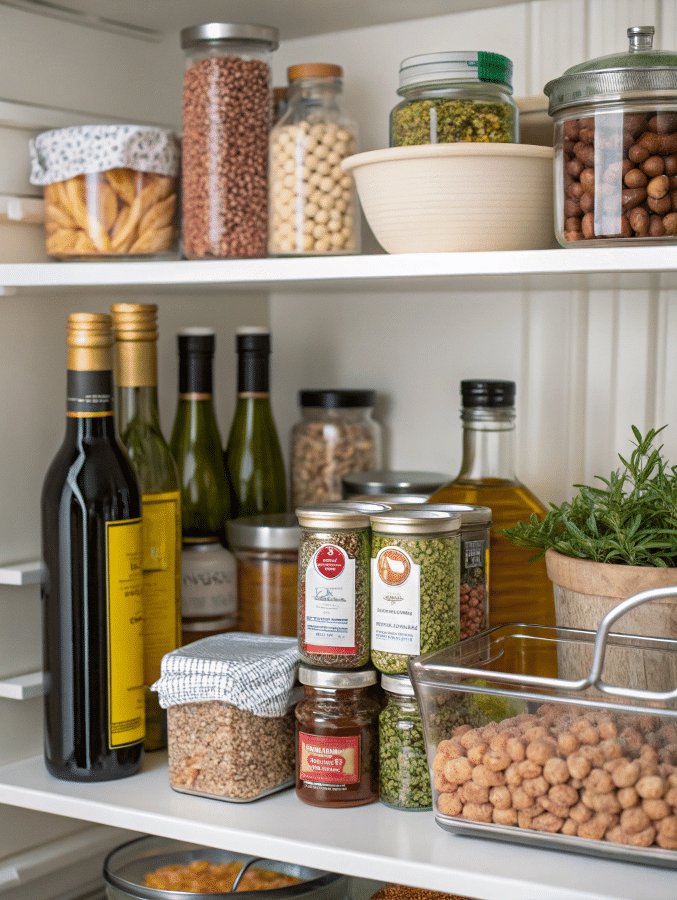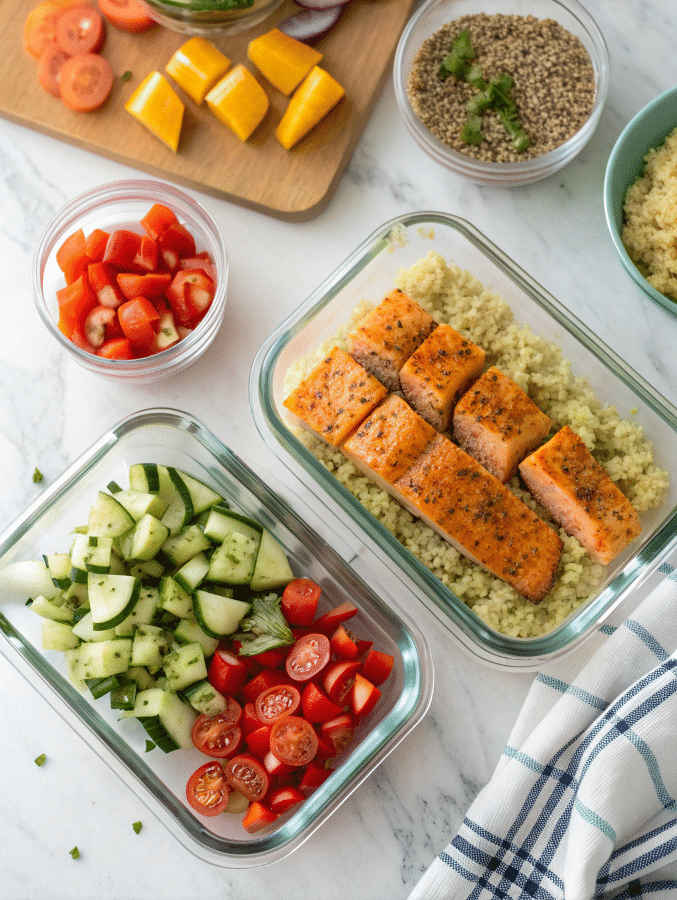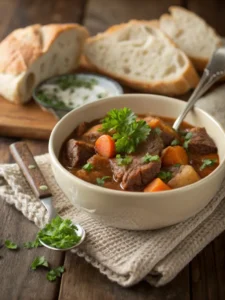
Mediterranean diet is more than just a way of eating, it’s a lifestyle rooted in fresh, wholesome ingredients and heart-healthy habits. From colorful vegetables to rich olive oil and lean seafood, it’s a sustainable approach that supports long-term wellness, weight balance, and anti-inflammatory benefits. In this guide, you’ll discover exactly what to eat, what to avoid, and how to make this flavorful diet part of your daily life, without overthinking it.
In this Article
Key Takeaways: What You Need to Know
- The Mediterranean diet emphasizes whole foods, healthy fats, and plant-forward meals that support long-term health.
- It’s not a restrictive plan, cheese, eggs, peanut butter, and even potatoes can be enjoyed in moderation.
- Backed by science, this way of eating is proven to reduce inflammation and improve heart health.
- Flexible and flavorful, it’s one of the easiest diets to stick with, no calorie counting or extreme rules.
- Real-life pantry swaps and a 7-day plan make it simple to get started today.
A Fresh Start in My Austin Kitchen
I still remember the first time I tossed ripe tomatoes, olive oil, and fresh herbs into a bowl and thought, wow, this is what food should taste like. It was just a random Tuesday in my little Austin kitchen, but something about the colors, the scent, the simplicity, it felt real. That’s how I stumbled into the Mediterranean diet. Not through a doctor’s recommendation or a health trend, but by following my taste buds.
Back then, I wasn’t aiming for a “diet.” I was just trying to make food that tasted good and made me feel even better. Over time, the more I learned about the Mediterranean diet, the more it made sense. No food groups eliminated. No calorie counting. Just real ingredients, fresh, heart-healthy, and deeply satisfying.
Since that day, my pantry has grown to include olive oil by the gallon, wild tuna, dried lentils, and every herb you can imagine. Dinners became less about perfection and more about connection. This way of eating isn’t just about health, it’s about joy. And that’s why I’m excited to share it with you here on WeTasteRecipes.com.
Why the Mediterranean Diet Resonates
At its core, the Mediterranean diet is inspired by the traditional eating patterns of countries like Greece, Italy, and Spain. But don’t let “diet” fool you, this isn’t restrictive. It’s a way of eating rooted in balance, freshness, and flavor. Think olive oil drizzled over roasted vegetables, a bowl of lentil soup with whole grain bread, or grilled salmon with fresh lemon and herbs. Simple. Real. Nourishing.
The Mediterranean diet is widely celebrated for its benefits. It’s been shown to:
- Support heart health
- Promote healthy weight management
- Offer powerful anti-inflammatory effects
- Reduce risk of chronic diseases like type 2 diabetes
But what makes this lifestyle really stick is how approachable it feels. Unlike strict weight-loss programs, the Mediterranean diet welcomes foods like cheese, eggs, peanut butter, and even a glass of red wine, all in moderation. You’re encouraged to focus on whole foods, colorful produce, and good fats like olive oil and nuts.
I’ve even found myself relying on flavorful, mineral-rich ingredients like Celtic salt and incorporating occasional tweaks like the pink salt weight loss recipe to add a healthful punch to my meals.
So whether you’re looking to lower inflammation, find a sustainable eating plan, or just make meals that feel good again, this is your starting point.
What to Eat and Avoid on a Mediterranean Diet

Top 10 Mediterranean Diet Foods
At the heart of the Mediterranean diet is a beautiful balance of plant-based foods, healthy fats, lean proteins, and whole grains. You don’t need fancy ingredients or complicated recipes, just real, nourishing staples.
Here are ten essential foods that belong in your Mediterranean pantry:
| Food | Why It’s Included |
|---|---|
| Extra virgin olive oil | Rich in heart-healthy monounsaturated fats |
| Leafy greens | Loaded with fiber, vitamins, and antioxidants |
| Tomatoes | A key source of lycopene, an anti-inflammatory compound |
| Whole grains (like farro, brown rice, oats) | Support steady blood sugar and sustained energy |
| Legumes (chickpeas, lentils) | Packed with plant-based protein and fiber |
| Fatty fish (salmon, sardines) | Rich in omega-3s to support heart and brain health |
| Nuts and seeds | Great for snacking and essential for healthy fat intake |
| Yogurt and cheese | Support gut health and calcium needs (in moderation) |
| Fresh fruit (berries, apples, grapes) | Naturally sweet and full of antioxidants |
| Herbs & spices | Flavor without added salt or sugar |
Even just adding a few of these items to your routine can help you get started. For example, I often build salads with cucumbers, chickpeas, and tomatoes, then dress them with olive oil and lemon.
Foods to Avoid (and Easy Swaps)
One of the reasons people love the Mediterranean diet is that it’s not about strict rules, it’s about smarter choices. That said, here are some foods to limit or avoid if you’re sticking to the Mediterranean way:
- Processed meats (like deli ham or hot dogs)
- Refined carbs (white bread, white rice, pastries)
- Sugary snacks and soft drinks
- Trans fats (often found in margarine or packaged snacks)
Instead of cutting everything out overnight, try these realistic swaps:
| Swap This | For This |
|---|---|
| White bread | Sprouted or whole grain bread |
| Soda | Infused water or herbal tea |
| Chips | Roasted chickpeas or nuts |
| Ice cream | Greek yogurt with fruit |
| Butter | Extra virgin olive oil |
Making thoughtful swaps like these adds up. For example, when trying the pink salt trick in one of my early recipe experiments, I found that pairing natural sea salts with whole foods made the biggest difference in both taste and how I felt after eating. The Himalayan pink salt weight loss recipe offers a mineral-rich alternative to processed condiments, aligning perfectly with Mediterranean values.
Why the Mediterranean Diet Is Anti-Inflammatory by Nature
Backed by Science
The Mediterranean diet isn’t just a trend, it’s one of the most extensively studied and recommended eating patterns by nutrition experts, researchers, and even cardiologists. One of its most important benefits? It’s naturally anti-inflammatory.
Chronic inflammation has been linked to heart disease, obesity, diabetes, arthritis, and even cognitive decline. Fortunately, the Mediterranean diet is packed with foods known to reduce these risks. Foods like extra virgin olive oil, salmon, leafy greens, and berries are all shown to lower inflammatory markers in the body.
Several studies have found that following a Mediterranean diet can significantly reduce levels of C-reactive protein (CRP), a key indicator of inflammation in the blood. In fact, a 2018 study published in The Journal of Nutrition showed that those who adhered closely to the Mediterranean diet had lower inflammation and reduced risk of metabolic syndrome.
This makes it a perfect option for those dealing with joint pain, gut issues, or autoimmunity, and it’s far more sustainable than restrictive elimination diets. The Mediterranean diet helps by nourishing your body with antioxidants, healthy fats, and fiber-rich foods that calm rather than trigger your system.
How Inflammation Shows Up in Daily Life
You might not always feel inflammation, but it shows up in the form of bloating, fatigue, brain fog, and even poor skin health. Choosing a diet that fights this process is one of the smartest long-term moves you can make.
What makes the Mediterranean diet unique is that it fights inflammation without being extreme. It doesn’t cut out entire food groups or focus on short-term detoxes. Instead, it prioritizes balance: colorful fruits and vegetables, omega-3-rich seafood, anti-inflammatory herbs like garlic and turmeric, and fermented dairy like yogurt.
When I tried incorporating more of these principles, I noticed results within days, less puffiness, more energy, and better digestion. Swapping processed foods for a handful of walnuts or trading sugary sauces for olive oil with herbs makes a bigger difference than you’d expect.
Even in something as simple as my homemade vinaigrette, I rely on unprocessed, mineral-rich ingredients. I love experimenting with different variations of the pink salt trick recipe to naturally enhance flavor and preserve nutrients. Blending ingredients like olive oil, garlic, and pink salt aligns perfectly with anti-inflammatory principles.
One unique twist I explored was combining Mediterranean ingredients with cooling effects, like in the Japanese pink salt and ice recipe. While not traditional, it showcases the versatility of whole ingredients that support your body’s natural healing.
By centering your meals around the Mediterranean diet, you’re not just eating healthier, you’re giving your body a daily dose of healing.
Mediterranean Diet vs Other Diets: What Sets It Apart
Mediterranean Diet vs DASH and Mayo Clinic Diet
When it comes to heart-healthy eating plans, the Mediterranean diet, the DASH diet, and the Mayo Clinic diet often top the list. But while they all aim to reduce chronic disease and improve overall health, the Mediterranean diet stands out for its flexibility, cultural depth, and taste-forward approach.
The DASH diet (Dietary Approaches to Stop Hypertension) focuses specifically on lowering blood pressure. It emphasizes low sodium, lean protein, and whole grains, but lacks the healthy fats central to the Mediterranean way of eating.
The Mayo Clinic diet is built around a food pyramid that encourages more fruits, vegetables, and physical activity, but its approach is often more weight-loss oriented, involving phases and calorie control. The Mediterranean diet, on the other hand, encourages intuitive eating and enjoying meals with others, without calorie counting or rigid rules.
Here’s a quick comparison to make the differences clearer:
| Feature | Mediterranean Diet | DASH Diet | Mayo Clinic Diet |
|---|---|---|---|
| Fat Focus | Healthy fats like olive oil and nuts | Low-fat focus | Moderate fat, portion controlled |
| Flexibility | Highly flexible and sustainable | Structured, lower sodium | Phased weight loss system |
| Ease of Use | Simple to follow with familiar foods | Requires label-reading and planning | Involves meal tracking and phases |
Overall, the Mediterranean diet is easier to adopt as a lifestyle. It aligns beautifully with everyday cooking, especially if you enjoy ingredients like fresh herbs, citrus, garlic, legumes, and seafood. Plus, there’s no “off-limits” list, just smarter, balanced choices.
Mediterranean Diet vs Low-Carb and Trendy Fads
Unlike low-carb or high-fat fad diets, the Mediterranean diet doesn’t rely on extremes. You won’t be counting grams of carbs or cutting out entire food groups. Instead, the Mediterranean diet encourages you to eat with purpose, choosing nutrient-dense ingredients that support your body over time.
Low-carb diets often emphasize animal-based protein and fat, which may increase inflammation and cholesterol when not balanced with plant-based foods. The Mediterranean diet takes a more balanced approach, combining healthy fats with whole grains, vegetables, legumes, and lean proteins from the sea.
It’s not just about looking better, it’s about feeling better, too. You’ll notice more stable energy, better digestion, and long-term health improvements. In fact, this eating style has inspired many of my own experiments, like integrating pink salt diet recipes to replace processed seasoning blends, or rethinking sodium with pink salt weight loss recipes that align with Mediterranean values.
Many popular diets fall apart after a few weeks. The Mediterranean diet becomes second nature because it’s satisfying, delicious, and practical, something you can enjoy for a lifetime.
Stocking a Mediterranean Diet Pantry for Everyday Success
What to Stock for a Successful Mediterranean Diet
Building a Mediterranean diet pantry doesn’t require exotic ingredients, it’s all about fresh, whole, nutrient-dense staples you can use in dozens of meals. When your kitchen is stocked with the right foods, following the Mediterranean diet becomes second nature.
Here’s what you’ll want to keep on hand to make the Mediterranean diet work in your daily routine:
- Extra virgin olive oil – This is the cornerstone of the Mediterranean diet. Use it for dressings, roasting, and sautéing.
- Canned beans – Chickpeas, lentils, and white beans make fast meals that are filling and full of fiber.
- Whole grains – Stock farro, quinoa, brown rice, and whole grain pasta for easy meal bases.
- Tinned fish – Sardines, tuna, and salmon offer a quick protein source rich in omega-3s.
- Fresh and frozen vegetables – Think spinach, kale, zucchini, tomatoes, cucumbers, and bell peppers.
- Herbs and spices – Garlic, rosemary, oregano, mint, and basil add flavor without sodium.
- Nuts and seeds – Almonds, walnuts, pumpkin seeds, and sunflower seeds make ideal snacks.
- Plain yogurt and hard cheeses – Greek yogurt and cheeses like feta or Parmesan add protein and probiotics.
- Fresh fruit – Apples, grapes, oranges, melons, and berries keep things colorful and naturally sweet.
The Mediterranean diet prioritizes simplicity, which is why I love the way it makes shopping and cooking feel less overwhelming. I always keep a jar of olives and canned tuna on standby for quick protein-packed lunches. It also gives me more confidence to skip processed foods and stick to clean, satisfying ingredients.
Smart Mediterranean Diet Swaps That Make a Big Impact
What I love about the Mediterranean diet is how it encourages thoughtful swaps instead of restrictive rules. You don’t need to cut everything out, you just trade up.
| Common Item | Mediterranean Swap |
|---|---|
| Butter | Extra virgin olive oil |
| Sour cream | Greek yogurt |
| Chips | Roasted chickpeas or almonds |
| White bread | Whole grain or sprouted bread |
| Store-bought salad dressing | Olive oil + lemon + herbs |
| Bacon or sausage | Grilled fish or lentils |
| Sugary desserts | Fresh fruit or yogurt with honey |
These tiny changes add up. By swapping processed snacks for whole foods, you’re not just improving your meals, you’re transforming your health. I even applied these swaps when trying the pink salt recipe to lose weight and blending it into a simple tomato and cucumber salad with extra virgin olive oil.
And when I want something cooling yet mineral-rich, I’ll borrow from global inspiration like the Oprah pink salt recipe, pairing it with sliced avocado and olive oil. These small flavor additions keep my Mediterranean-style meals exciting and satisfying.
The Mediterranean diet isn’t about perfection. It’s about creating a lifestyle filled with real ingredients, joyful meals, and small consistent choices. The pantry you build today lays the foundation for a healthier tomorrow.
Mediterranean Diet Meal Plan: 7 Delicious Days of Real Food
7-Day Real Food Mediterranean Diet Plan
One of the best parts of the Mediterranean diet is how effortless it feels once you start. You’re not stuck with bland meals or endless prep. With just a few basic ingredients, you can create vibrant, satisfying dishes every day.
Here’s a sample 7-day meal plan to help you put the Mediterranean diet into action:
| Day | Breakfast | Lunch | Dinner |
|---|---|---|---|
| Monday | Greek yogurt, berries, and walnuts | Chickpea salad with cucumbers and olives | Grilled salmon with farro and sautéed greens |
| Tuesday | Avocado toast on whole grain bread | Lentil soup with a side of feta-topped greens | Baked eggplant with tomatoes and quinoa |
| Wednesday | Oats with dates, almonds, and a drizzle of honey | Hummus wrap with veggies and olives | Tuna with brown rice and roasted carrots |
| Thursday | Smoothie with spinach, banana, and Greek yogurt | Mediterranean grain bowl with chickpeas and tzatziki | Stuffed bell peppers with lentils and herbs |
| Friday | Scrambled eggs with spinach and whole grain toast | Tomato and cucumber salad with grilled shrimp | Whole wheat pasta with olive oil and garlic |
| Saturday | Greek yogurt parfait with seeds and fruit | Caprese salad with chickpeas and arugula | Grilled chicken with roasted sweet potatoes |
| Sunday | Whole grain pancakes with banana and honey | Quinoa salad with roasted veggies and tahini | Grilled fish with tabbouleh and sautéed kale |
Meals like these are what make the Mediterranean diet not just doable, but enjoyable. Most of these can be prepped in under 30 minutes with what you already have.
Mediterranean Diet Snacks and Dressings You’ll Love
You don’t have to give up flavor to eat healthy. With the Mediterranean diet, snacks and dressings are as wholesome as your meals.
Smart Mediterranean Diet Snack Ideas:
- A handful of almonds or walnuts
- Sliced apples with peanut butter
- Cucumber slices with hummus
- Plain Greek yogurt with honey
- Hard-boiled eggs with olive oil drizzle
Simple Mediterranean Salad Dressing:
One of my go-to dressings is just olive oil, fresh lemon juice, crushed garlic, and a pinch of pink salt. This basic combo turns any salad into a restaurant-quality bite, without added sugar or chemicals.
I’ve even combined it with ideas from my pink salt diet recipe to create unique flavor variations that stay true to the Mediterranean way of eating.
Every snack and dressing on the Mediterranean diet supports energy, gut health, and inflammation reduction, without ever feeling like you’re “on a diet.”
Conclusion: A Lifestyle That Feeds Your Body and Spirit

Eating well doesn’t have to feel like a chore or a checklist. It can be flavorful, joyful, and something you look forward to every day. When meals are built on fresh ingredients, vibrant flavors, and time-honored traditions, they become more than fuel, they become a source of connection, comfort, and creativity.
This way of eating invites you to slow down, enjoy your food, and focus on what truly nourishes you from the inside out. Whether you’re in it for heart health, energy, or simply the love of a good homemade meal, there’s beauty in simplicity, and power in small, consistent choices.
For more evidence-based information on healthy eating patterns, visit the National Institutes of Health’s nutrition guide. It’s a trusted resource that offers practical insights into building lifelong habits that support overall well-being.
So tonight, gather around the table. Savor every bite. And know that each step toward better eating is a step toward feeling better—for good.
FAQs: What You’ve Been Asking
What are the top 10 foods on a Mediterranean diet?
The top foods in a Mediterranean diet include:
Extra virgin olive oil
Leafy greens and vegetables
Fresh fruits like berries and grapes
Whole grains (quinoa, farro, oats)
Legumes (chickpeas, lentils)
Fatty fish (salmon, sardines)
Nuts and seeds (almonds, walnuts)
Garlic and fresh herbs
Plain Greek yogurt and aged cheese
Tomatoes and olives
These nutrient-rich foods form the foundation of a Mediterranean diet, delivering fiber, healthy fats, antioxidants, and anti-inflammatory properties.
What foods can you not eat in a Mediterranean diet?
Foods to avoid in a Mediterranean diet include:
Sugary drinks and desserts
Refined grains like white bread
Processed meats and fried foods
Trans fats and hydrogenated oils
Highly processed packaged snacks
The Mediterranean diet favors whole, minimally processed ingredients, focusing on balance rather than strict restrictions.
Are eggs eaten in a Mediterranean diet?
Yes, eggs are included in the Mediterranean diet in moderation. A few servings per week are typical, often paired with vegetables, whole grains, or olive oil for a complete meal. Scrambled eggs with spinach and tomatoes make a Mediterranean-friendly breakfast.
Is the Mediterranean diet anti-inflammatory?
Yes, the Mediterranean diet is known for its anti-inflammatory properties. Its high content of omega-3 fatty acids, antioxidants, fiber, and polyphenols from olive oil, nuts, and vegetables helps reduce inflammation naturally.
What is the difference between the DASH diet and the Mediterranean diet?
Both diets emphasize heart health, but the Mediterranean diet focuses on healthy fats like olive oil and includes moderate alcohol, while DASH limits sodium and saturated fats more strictly. Mediterranean meals are more flexible and culturally varied.
Is cheese allowed on the Mediterranean diet?
Yes, cheese is allowed in moderation on the Mediterranean diet. Stick with traditional varieties like feta, Parmesan, or Pecorino, and enjoy them alongside vegetables, grains, or fruit, not processed meats or white bread.
Is peanut butter allowed on a Mediterranean diet?
Yes, natural peanut butter is allowed on the Mediterranean diet. Choose a variety with no added sugar or hydrogenated oils. It pairs well with apple slices or whole grain toast as a fiber-rich snack.
Are bananas okay on the Mediterranean diet?
Absolutely. Bananas are naturally sweet and rich in potassium, making them a great addition to the Mediterranean diet, especially as part of a smoothie, snack, or breakfast bowl with nuts and yogurt.
Can I eat potatoes on a Mediterranean diet?
Yes, potatoes are included in the Mediterranean diet, especially when prepared healthfully, think roasted with olive oil and herbs. Avoid deep frying or loading them with butter and processed toppings.
What is the best salad dressing for a Mediterranean diet?
A simple vinaigrette made from extra virgin olive oil, lemon juice, garlic, and herbs is ideal for the Mediterranean diet. It’s flavorful, anti-inflammatory, and free of added sugars or preservatives.
Is the Mayo Clinic diet similar to the Mediterranean diet?
The Mayo Clinic diet shares similarities with the Mediterranean diet, such as an emphasis on plant-based foods and physical activity. However, it often includes structured phases and calorie tracking, unlike the more intuitive Mediterranean approach.
What is the best diet for inflammation?
The Mediterranean diet is widely considered the best diet for inflammation due to its emphasis on antioxidant-rich fruits, vegetables, omega-3 fats, and whole grains. It helps reduce chronic inflammation without the need for strict elimination.


